| Season Start: | 06 September 1986 | | Season End: | 06 December 1986 | | Season Length: | 14 Weeks | | Writers: | Philip Martin, Pip and Jane Baker and Robert Holmes | | Directors: | Chris Clough, Nicholas Mallett and Ron Jones | | Producer: | John Nathan-Turner | | Script Editors: | Eric Saward and John Nathan-Turner | | Visual Effects: | Kevin Molloy, Mike Kelt and Peter Wragg | | Title Sequence: | Sid Sutton and Terry Handley | | Title Music: | Ron Grainer and the BBC Radiophonic Workshop. Arranged by Dominic Glynn |
|
Incarnation of the Doctor: |
The Sixth Doctor
|
| Number of
Companions: |
2 |
| The
Companions: |
Peri (Departs) and Melanie Bush (Joins)
|
| Number of
Acquaintances: |
1
|
| The
Acquaintances: |
Sabalom Glitz (Joins and Departs)
|
| Number of
Stories: |
4
|
| Number of
Incomplete/Missing Stories: |
0
|
| Number of
Episodes: |
14
|
| Number of
Incomplete/Missing Episodes: |
0
|
| Percentages: |
| Full Stories Held | 100% | | Episodes Held | 100% |
|
| Doctor Who Magazine Poll (1998) | | | Doctor Who Magazine Poll (2009) | | | Doctor Who Magazine Poll (2014) | |
|
 'The single purpose of this trial is to determine the defendant's guilt or otherwise on the basis of the evidence that has been presented. Anything else is, for the moment, irrelevant!' 'The single purpose of this trial is to determine the defendant's guilt or otherwise on the basis of the evidence that has been presented. Anything else is, for the moment, irrelevant!'
The Inquisitor
(The Ultimate Foe) |
|
|
|
|
| |
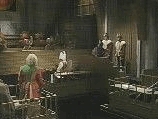 |
| In The Courtroom |
|
 With the shock announcement halfway through Season Twenty Two that the next season would be delayed as the show went on a hiatus it was with great relief when work on Season Twenty Three finally started - so belaying any fears that the show had been cancelled. With the shock announcement halfway through Season Twenty Two that the next season would be delayed as the show went on a hiatus it was with great relief when work on Season Twenty Three finally started - so belaying any fears that the show had been cancelled.
 A number of reasons for the eighteen-month hiatus were given: Season Twenty Two’s ratings, to that point in the show’s history, were the lowest since Tom Baker’s final season in 1980. The programme had been criticised in some quarters for being too violent and humourless and also the BBC was facing a financial shortfall in early 1985, with the premiere of its expensive new soap opera EastEnders and the early debut of its Daytime News Service in advance of a similar offering by rival ITV. On top of this, there was almost certainly a degree of animosity directed towards Doctor Who by some BBC administrators - which was nothing new as this had been the case throughout virtually the show’s entire history. A number of reasons for the eighteen-month hiatus were given: Season Twenty Two’s ratings, to that point in the show’s history, were the lowest since Tom Baker’s final season in 1980. The programme had been criticised in some quarters for being too violent and humourless and also the BBC was facing a financial shortfall in early 1985, with the premiere of its expensive new soap opera EastEnders and the early debut of its Daytime News Service in advance of a similar offering by rival ITV. On top of this, there was almost certainly a degree of animosity directed towards Doctor Who by some BBC administrators - which was nothing new as this had been the case throughout virtually the show’s entire history.
 Although frequently called an ‘Eighteen-month hiatus’, the broadcast of the first story of Season Twenty Three was only delayed by about nine months. As this season returned to an autumn broadcast, as had been the standard during most seasons of the eras of the First Doctor, Second Doctor and Fourth Doctor. While this was technically the longest break between seasons of the original run of the show, it was not entirely without precedent. Throughout the show’s history, the BBC has changed the part of the year in which the show was broadcast, meaning that there has never been a standard gap between seasons. During the eras of the First Doctor and the Second Doctor viewers were used to gaps of only a few months between seasons. They were then forced to endure a six-month gap between Season Six and Season Seven. A gap of six months then became the standard for the Third Doctor and Fourth Doctor eras. However, the exact opposite of what happened between Season Twenty Two and Season Twenty Three occurred between Season Twelve and Season Thirteen. Then the BBC reduced the gap between the two seasons to just three months in its desire to return the show to an autumn schedule. Things changed substantially immediately upon Tom Baker’s departure. Viewers had to wait nine months between his final story and the Fifth Doctor’s first story. The new twice-weekly broadcast schedule reduced the total time of a season to just three months. This resulted in nine-month gaps becoming the standard for the rest of the original run of the show - expect between Season Twenty Two and Season Twenty Three. Although frequently called an ‘Eighteen-month hiatus’, the broadcast of the first story of Season Twenty Three was only delayed by about nine months. As this season returned to an autumn broadcast, as had been the standard during most seasons of the eras of the First Doctor, Second Doctor and Fourth Doctor. While this was technically the longest break between seasons of the original run of the show, it was not entirely without precedent. Throughout the show’s history, the BBC has changed the part of the year in which the show was broadcast, meaning that there has never been a standard gap between seasons. During the eras of the First Doctor and the Second Doctor viewers were used to gaps of only a few months between seasons. They were then forced to endure a six-month gap between Season Six and Season Seven. A gap of six months then became the standard for the Third Doctor and Fourth Doctor eras. However, the exact opposite of what happened between Season Twenty Two and Season Twenty Three occurred between Season Twelve and Season Thirteen. Then the BBC reduced the gap between the two seasons to just three months in its desire to return the show to an autumn schedule. Things changed substantially immediately upon Tom Baker’s departure. Viewers had to wait nine months between his final story and the Fifth Doctor’s first story. The new twice-weekly broadcast schedule reduced the total time of a season to just three months. This resulted in nine-month gaps becoming the standard for the rest of the original run of the show - expect between Season Twenty Two and Season Twenty Three.
 When Season Twenty Three finely appeared on our screens it was though very different to the one that had been originally planned. There were two main reasons why significant alterations were required to the original plans. Firstly BBC1 Controller Michael Grade and Head of Drama Jonathan Powell had decided that Season Twenty Two’s experiment with forty-five-minute episodes had been a failure. This was despite it being watched by 7.1 million viewers - which is the same as the previous two seasons - and John Nathan-Turner and Eric Saward’s contention that it was simply taking them time to come to grips with the new format. Consequently, all the scripts in progress would have to be modified to fit the more traditional twenty-five minute length. But this proved to be no easy task. When Season Twenty Three finely appeared on our screens it was though very different to the one that had been originally planned. There were two main reasons why significant alterations were required to the original plans. Firstly BBC1 Controller Michael Grade and Head of Drama Jonathan Powell had decided that Season Twenty Two’s experiment with forty-five-minute episodes had been a failure. This was despite it being watched by 7.1 million viewers - which is the same as the previous two seasons - and John Nathan-Turner and Eric Saward’s contention that it was simply taking them time to come to grips with the new format. Consequently, all the scripts in progress would have to be modified to fit the more traditional twenty-five minute length. But this proved to be no easy task.
 With the episodes reverting back to the standard twenty five minutes in length, a reduction in the total number of episodes (from twenty six to just fourteen) and a toning down of the violence it was therefore decided that all the original stories, that were in different stages of pre-production, were to be shelved. With the episodes reverting back to the standard twenty five minutes in length, a reduction in the total number of episodes (from twenty six to just fourteen) and a toning down of the violence it was therefore decided that all the original stories, that were in different stages of pre-production, were to be shelved.
 The stories intended for the abandoned season included: "The Nightmare Fair" by Graham Williams, "The Ultimate Evil" by Wally K. Daly, "Mission to Magnus" (aka "Planet of Storms") by Philip Martin, and "Yellow Fever and How to Cure It" by Robert Holmes. Most of these stories have since been released as either books or as audios. The latter of which are performed by Colin Baker and Nicola Bryant, both reprising their roles as the Sixth Doctor and his travelling companion Peri. The stories intended for the abandoned season included: "The Nightmare Fair" by Graham Williams, "The Ultimate Evil" by Wally K. Daly, "Mission to Magnus" (aka "Planet of Storms") by Philip Martin, and "Yellow Fever and How to Cure It" by Robert Holmes. Most of these stories have since been released as either books or as audios. The latter of which are performed by Colin Baker and Nicola Bryant, both reprising their roles as the Sixth Doctor and his travelling companion Peri.
 The reduction in the number of episodes for Season Twenty Three, from twenty six to fourteen, meant nearly a 50% drop in seasonal output as compared with previous seasons. This meant that John Nathan-Turner and Eric Saward needed to approach the format of this season more creatively than in the past – and so they came up with the idea of the entire season consisting of The Doctor being put on trial by the Time Lords - effectively mirroring the show’s real-life status. The reduction in the number of episodes for Season Twenty Three, from twenty six to fourteen, meant nearly a 50% drop in seasonal output as compared with previous seasons. This meant that John Nathan-Turner and Eric Saward needed to approach the format of this season more creatively than in the past – and so they came up with the idea of the entire season consisting of The Doctor being put on trial by the Time Lords - effectively mirroring the show’s real-life status.
 The broadcasted Season Twenty Three therefore consisted of one 14-episode story made up of four distinct segments. This is not the first time that a whole season had been made up of interlocking stories. This had occurred with Season Sixteen (aka The Key to Time). However, Season Sixteen had been made up of six separate stories with an over-reaching storyline involving the Fourth Doctor and Romana's quest for The Key to Time segments. Whereas all fourteen episodes of Season Twenty Three came under the umbrella title, The Trial of a Timelord, it was only after broadcast that Target Books released separate novels for the four segments which made up this season-length storyline. The structure of this season was inspired by Charles Dickens’ novel A Christmas Carol, with The Valeyard and The Doctor using adventures from The Doctor’s past, present and future as evidence. The broadcasted Season Twenty Three therefore consisted of one 14-episode story made up of four distinct segments. This is not the first time that a whole season had been made up of interlocking stories. This had occurred with Season Sixteen (aka The Key to Time). However, Season Sixteen had been made up of six separate stories with an over-reaching storyline involving the Fourth Doctor and Romana's quest for The Key to Time segments. Whereas all fourteen episodes of Season Twenty Three came under the umbrella title, The Trial of a Timelord, it was only after broadcast that Target Books released separate novels for the four segments which made up this season-length storyline. The structure of this season was inspired by Charles Dickens’ novel A Christmas Carol, with The Valeyard and The Doctor using adventures from The Doctor’s past, present and future as evidence.
 While uneven and sometimes still very violent, there were a number of new characters and villains introduced during this season. These included: The Valeyard - an amalgamation of The Doctor’s darker nature, somewhere between his twelfth and final incarnation -, The Inquisitor, mercenary Sabalom Glitz, and the Vervoids. Along with the Sixth Doctor, The Valeyard and The Inquisitor are present for all fourteen episodes of this season. While uneven and sometimes still very violent, there were a number of new characters and villains introduced during this season. These included: The Valeyard - an amalgamation of The Doctor’s darker nature, somewhere between his twelfth and final incarnation -, The Inquisitor, mercenary Sabalom Glitz, and the Vervoids. Along with the Sixth Doctor, The Valeyard and The Inquisitor are present for all fourteen episodes of this season.
 As well as the new characters this season included the return of the villainous Sil (from Thoros-Beta), who had first appeared in "Vengeance on Varos", and The Master - The Doctor’s arch-enemy. The most significant change during this season though was the controversial departure of Peri and the disjointed arrival of new companion Melaine Bush. As well as the new characters this season included the return of the villainous Sil (from Thoros-Beta), who had first appeared in "Vengeance on Varos", and The Master - The Doctor’s arch-enemy. The most significant change during this season though was the controversial departure of Peri and the disjointed arrival of new companion Melaine Bush.
 Nicola Bryant, who played companion Peri, was beginning to worry that her acting career was being hampered by a prolonged association with the show and so it had been decided to replace Peri with new companion Melanie Bush mid-season. "Mindwarp" therefore marked the final appearance of Peri - who is apparently killed when her body becomes the host for Kiv. Nicola Bryant, who played companion Peri, was beginning to worry that her acting career was being hampered by a prolonged association with the show and so it had been decided to replace Peri with new companion Melanie Bush mid-season. "Mindwarp" therefore marked the final appearance of Peri - who is apparently killed when her body becomes the host for Kiv.
 In an attempt to end the season on a more optimistic note John Nathan-Turner decided to reveal, at the end of "The Ultimate Foe", that Peri had not died after all but had in fact survived and was now happily married to King Yrcanos - so making her apparent death a part of The Valeyard’s tampering with the Matrix. It has since been revealed though that Nicola Bryant was disappointed to learn how the fate of her character had been changed. In an attempt to end the season on a more optimistic note John Nathan-Turner decided to reveal, at the end of "The Ultimate Foe", that Peri had not died after all but had in fact survived and was now happily married to King Yrcanos - so making her apparent death a part of The Valeyard’s tampering with the Matrix. It has since been revealed though that Nicola Bryant was disappointed to learn how the fate of her character had been changed.
 "Terror of the Vervoids", the story that followed "Mindwarp", featured the first appearance of Melanie Bush - played by the much-maligned Bonnie Langford. Thanks to the paradoxes of time travel, since Melanie Bush is from The Doctor’s future, she has already met him, but from The Doctor’s perspective he is meeting her for the first time. Melanie Bush is therefore introduced without the typical ‘meeting’ story and with no explanation of how she came to be travelling with The Doctor. "Terror of the Vervoids", the story that followed "Mindwarp", featured the first appearance of Melanie Bush - played by the much-maligned Bonnie Langford. Thanks to the paradoxes of time travel, since Melanie Bush is from The Doctor’s future, she has already met him, but from The Doctor’s perspective he is meeting her for the first time. Melanie Bush is therefore introduced without the typical ‘meeting’ story and with no explanation of how she came to be travelling with The Doctor.
 After the stability of previous three seasons great changes occurred during the making of this season. When the show returned after its eighteen month hiatus it was a mere shadow of its former self. The production of this season was fraught with problems especially with the final six episodes. The penultimate story, "Terror of the Vervoids", was finally written by writing team Pip and Jane Baker, who had previously written last season’s "The Mark of The Rani". But this was after four other writers producing storylines which ultimately were not accepted by either John Nathan-Turner or Eric Saward for varying reasons. The biggest problem though occurred with the final story, "The Ultimate Foe". This two-part story was due to be written by former Script Editor Robert Holmes. But due to delays in completing "The Mysterious Planet" and an illness that ended with the death of this very popular writer, Eric Saward ended up re-writing the first episode and writing the second virtually himself. However, when Eric Saward decided to leave the show, after a number of disagreements, he did not allow the use of his second episode. Therefore John Nathan-Turner had to get Pip and Jane Baker to hurriedly write the final episode from scratch. With all this turmoil it was miraculous that The Trial of a Time Lord was able to be completed at all. After the stability of previous three seasons great changes occurred during the making of this season. When the show returned after its eighteen month hiatus it was a mere shadow of its former self. The production of this season was fraught with problems especially with the final six episodes. The penultimate story, "Terror of the Vervoids", was finally written by writing team Pip and Jane Baker, who had previously written last season’s "The Mark of The Rani". But this was after four other writers producing storylines which ultimately were not accepted by either John Nathan-Turner or Eric Saward for varying reasons. The biggest problem though occurred with the final story, "The Ultimate Foe". This two-part story was due to be written by former Script Editor Robert Holmes. But due to delays in completing "The Mysterious Planet" and an illness that ended with the death of this very popular writer, Eric Saward ended up re-writing the first episode and writing the second virtually himself. However, when Eric Saward decided to leave the show, after a number of disagreements, he did not allow the use of his second episode. Therefore John Nathan-Turner had to get Pip and Jane Baker to hurriedly write the final episode from scratch. With all this turmoil it was miraculous that The Trial of a Time Lord was able to be completed at all.
 Season Twenty Three though was not received very well by the viewing public. Hampered by the long break between seasons and potent opposition from American action import The A-Team, ratings for Season Twenty Three were even poorer than for the preceding year. Season Twenty Three though was not received very well by the viewing public. Hampered by the long break between seasons and potent opposition from American action import The A-Team, ratings for Season Twenty Three were even poorer than for the preceding year.
 By the time this season ended the three-year period which had marked Colin Baker’s tenure as the Sixth Doctor ended (not that Colin Baker was aware of this when the final story was recorded). This season ended what was perhaps the most arduous and trouble-filled period in the show’s twenty six year history. This is, of course, in no way representative of the man in the title role as Colin Baker had for many years been a well-regarded, highly renowned stage and television actor with a long list of credits behind him. Colin Baker had intended to play The Doctor longer than even Tom Baker’s seven-year stretch. It is unfortunate therefore that he became the only person to be fired from the role - the BBC authorities having mistakenly identified him as the person behind the show’s ratings troubles, when in fact it was the extraordinary talents of this gifted actor that lifted the show above the sometimes-mediocre scripting and uneven production values. By the time this season ended the three-year period which had marked Colin Baker’s tenure as the Sixth Doctor ended (not that Colin Baker was aware of this when the final story was recorded). This season ended what was perhaps the most arduous and trouble-filled period in the show’s twenty six year history. This is, of course, in no way representative of the man in the title role as Colin Baker had for many years been a well-regarded, highly renowned stage and television actor with a long list of credits behind him. Colin Baker had intended to play The Doctor longer than even Tom Baker’s seven-year stretch. It is unfortunate therefore that he became the only person to be fired from the role - the BBC authorities having mistakenly identified him as the person behind the show’s ratings troubles, when in fact it was the extraordinary talents of this gifted actor that lifted the show above the sometimes-mediocre scripting and uneven production values.
 Despite the bad treatment he received Colin Baker has since become one of Doctor Who’s most popular goodwill ambassadors. He returned for the Thirtieth-Anniversary Children In Need special "Dimensions in Time", in 1993 and then returned to star alongside Peter Davison, Sylvester McCoy and Paul McGann in Big Finish Production’s Doctor Who audio stories. He has become a popular guest at conventions across the world and his charm and character belies only a hint of the true potential of the Sixth Doctor, had Colin Baker been given a fighting chance to play the role as he had wanted. Despite the bad treatment he received Colin Baker has since become one of Doctor Who’s most popular goodwill ambassadors. He returned for the Thirtieth-Anniversary Children In Need special "Dimensions in Time", in 1993 and then returned to star alongside Peter Davison, Sylvester McCoy and Paul McGann in Big Finish Production’s Doctor Who audio stories. He has become a popular guest at conventions across the world and his charm and character belies only a hint of the true potential of the Sixth Doctor, had Colin Baker been given a fighting chance to play the role as he had wanted.
 As well as Colin Baker being sacked the production team also underwent a huge change with Producer John Nathan-Turner desperately wanting to leave, but instead being forced to stay for at least one more season. The biggest upset though was the sudden resignation of Script Editor Eric Saward who departed in a very bitter and very public fight with his former boss. This meant that John Nathan-Turner had to take on the role of Script Editor for the final two stories. As well as Colin Baker being sacked the production team also underwent a huge change with Producer John Nathan-Turner desperately wanting to leave, but instead being forced to stay for at least one more season. The biggest upset though was the sudden resignation of Script Editor Eric Saward who departed in a very bitter and very public fight with his former boss. This meant that John Nathan-Turner had to take on the role of Script Editor for the final two stories.
 After literally being put on trial the show had somehow survived and another season was to follow. But it was at a huge cost to both Colin Baker and John Nathan-Turner. It is a shame that at the time Doctor Who was in such turmoil, and that only luck and faith seemed to be able to keep it going. The two big questions at the time were: how long would the show last and would a new incarnation of The Doctor be enough to turn things around? After literally being put on trial the show had somehow survived and another season was to follow. But it was at a huge cost to both Colin Baker and John Nathan-Turner. It is a shame that at the time Doctor Who was in such turmoil, and that only luck and faith seemed to be able to keep it going. The two big questions at the time were: how long would the show last and would a new incarnation of The Doctor be enough to turn things around?
|
|
|
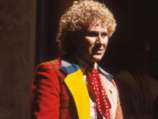 |
| The Doctor |
|
 Right from the start of the very first episode of this season it was clear that things had changed as Season Twenty Three started with a slightly more upbeat version of the theme music. Dominic Glynn, a young freelance musician was commissioned to provide the incidental music for "The Mysterious Planet". Dominic Glynn however, was also commissioned to rearrange the opening title music - although Dominic Glynn was only given five days to complete this task. His new score for the opening theme though was the shortest lived, lasting this season alone (not counting the unused 1973 version by Delia Derbyshire and Paddy Kingsland). While most fans saw it as an improvement on the Peter Howell version, others criticised it for being ‘too quiet’ or ‘not scary enough’. It has since been used on the majority of the Big Finish Productions audio stories featuring Colin Baker as the Sixth Doctor. Right from the start of the very first episode of this season it was clear that things had changed as Season Twenty Three started with a slightly more upbeat version of the theme music. Dominic Glynn, a young freelance musician was commissioned to provide the incidental music for "The Mysterious Planet". Dominic Glynn however, was also commissioned to rearrange the opening title music - although Dominic Glynn was only given five days to complete this task. His new score for the opening theme though was the shortest lived, lasting this season alone (not counting the unused 1973 version by Delia Derbyshire and Paddy Kingsland). While most fans saw it as an improvement on the Peter Howell version, others criticised it for being ‘too quiet’ or ‘not scary enough’. It has since been used on the majority of the Big Finish Productions audio stories featuring Colin Baker as the Sixth Doctor.
 Also to create a strong hook, to start off the new season, John Nathan-Turner agreed to spend more than £8,000 on a forty-five second model sequence, utilising what was then the most sophisticated motion-controlled camera available. (Fortunately, some of the cost would be offset by the fact that the portions of this footage would be reused as establishing shots throughout the whole season). This was the most expensive special effects sequence used, in the original run of the show, and depicts the Time Lord Space Station orbiting in space and then dragging the TARDIS inside via the use of a tractor beam. Also to create a strong hook, to start off the new season, John Nathan-Turner agreed to spend more than £8,000 on a forty-five second model sequence, utilising what was then the most sophisticated motion-controlled camera available. (Fortunately, some of the cost would be offset by the fact that the portions of this footage would be reused as establishing shots throughout the whole season). This was the most expensive special effects sequence used, in the original run of the show, and depicts the Time Lord Space Station orbiting in space and then dragging the TARDIS inside via the use of a tractor beam.
 Both of these items were viewed in the first five minutes of the season and are considered to be the best aspects of the whole of The Trial of a Time Lord season-long storyline. Both of these items were viewed in the first five minutes of the season and are considered to be the best aspects of the whole of The Trial of a Time Lord season-long storyline.
 Of the four stories that make up The Trial of a Time Lord, "Terror of the Vervoids" is the easiest to understand. Based on a typical Agatha Christie murder mystery, except set on a space liner, it is The Doctor’s opportunity during his trial to present a case for his defence. Ironically it ends with him committing an act of genocide against the Vervoids so prompting The Valeyard to call for The Doctor’s death if he is judged to be guilty. This now seemed to be forgone conclusion - despite The Doctor’s insistence that the evidence has been rigged against him. Of the four stories that make up The Trial of a Time Lord, "Terror of the Vervoids" is the easiest to understand. Based on a typical Agatha Christie murder mystery, except set on a space liner, it is The Doctor’s opportunity during his trial to present a case for his defence. Ironically it ends with him committing an act of genocide against the Vervoids so prompting The Valeyard to call for The Doctor’s death if he is judged to be guilty. This now seemed to be forgone conclusion - despite The Doctor’s insistence that the evidence has been rigged against him.
 This then leads into the final two episodes which ties up all the story threads of the previous three stories. The majority of "The Ultimate Foe" takes place inside the Matrix in the surreal fantasy world, created by The Valeyard, where nothing is at it seems. The Doctor of course finally defeats The Valeyard and, with the help of The Master, is able to have all the charges against him dropped. This then leads into the final two episodes which ties up all the story threads of the previous three stories. The majority of "The Ultimate Foe" takes place inside the Matrix in the surreal fantasy world, created by The Valeyard, where nothing is at it seems. The Doctor of course finally defeats The Valeyard and, with the help of The Master, is able to have all the charges against him dropped.
 But unknown to The Doctor and all those in the courtroom The Valeyard has the last laugh (literary) as at the very end of this story, when The Inquisitor departs the courtroom, she gives instructions to the Keeper of the Matrix. But as he looks up at the camera, he gives an evil chuckle, and is revealed to be The Valeyard… But unknown to The Doctor and all those in the courtroom The Valeyard has the last laugh (literary) as at the very end of this story, when The Inquisitor departs the courtroom, she gives instructions to the Keeper of the Matrix. But as he looks up at the camera, he gives an evil chuckle, and is revealed to be The Valeyard…
|
|
|
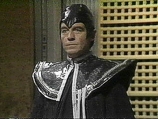 |
| The Valeyard |
|
 Not since Season Seven has there been a season that has only had four stories - if you count up the four segments that make up the fourteen episodes of The Trial of a Time Lord, the season-long storyline that constituted Season Twenty Three. Not since Season Seven has there been a season that has only had four stories - if you count up the four segments that make up the fourteen episodes of The Trial of a Time Lord, the season-long storyline that constituted Season Twenty Three.
 Because there are very few stories to choose from it is not easy to pick a good story from a season that at the time had not been received very well by the viewing public. With only an average 4.8 million viewers this season was the least popular to date. Because there are very few stories to choose from it is not easy to pick a good story from a season that at the time had not been received very well by the viewing public. With only an average 4.8 million viewers this season was the least popular to date.
 At the time of broadcast "Terror of the Vervoids" was the most watched with 5.1 million viewers, while "The Mysterious Planet" was the least watched. This was by only 4.4 million viewers - the least watched story to date. Since broadcast "The Ultimate Foe" has become the best liked story in the Doctor Who Magazine polls. While "Mindwarp" has joined "The Mysterious Planet" as being the least liked. At the time of broadcast "Terror of the Vervoids" was the most watched with 5.1 million viewers, while "The Mysterious Planet" was the least watched. This was by only 4.4 million viewers - the least watched story to date. Since broadcast "The Ultimate Foe" has become the best liked story in the Doctor Who Magazine polls. While "Mindwarp" has joined "The Mysterious Planet" as being the least liked.
 It is clear that the later parts of The Trial of a Time Lord are better liked than the early segments and this is despite the problems that were experienced during the production of the last six episodes and that they contained the much-maligned Bonnie Langford who played new companion Melanie Bush. It is clear that the later parts of The Trial of a Time Lord are better liked than the early segments and this is despite the problems that were experienced during the production of the last six episodes and that they contained the much-maligned Bonnie Langford who played new companion Melanie Bush.
 The high point of this season though has to go to the performance of Michael Jayston as The Valeyard - who turns out to be none other than the darkest side of The Doctor’s nature who originates from sometime between the time of the Twelfth Doctor and the Thirteenth Doctor. The popular theory is that he is a transitional stage between The Doctor's last two incarnations, rather like the Watcher in the 1981 Fourth Doctor story "Logpolis". The Valeyard is the prosecutor at The Doctor’s trial and is determined to kill The Doctor by rigging the evidence against The Doctor. Thankfully, with the help of The Master, The Doctor realises this and is able to thwart The Valeyard’s evil plans. The high point of this season though has to go to the performance of Michael Jayston as The Valeyard - who turns out to be none other than the darkest side of The Doctor’s nature who originates from sometime between the time of the Twelfth Doctor and the Thirteenth Doctor. The popular theory is that he is a transitional stage between The Doctor's last two incarnations, rather like the Watcher in the 1981 Fourth Doctor story "Logpolis". The Valeyard is the prosecutor at The Doctor’s trial and is determined to kill The Doctor by rigging the evidence against The Doctor. Thankfully, with the help of The Master, The Doctor realises this and is able to thwart The Valeyard’s evil plans.
|
|
|
|
|
| |
The Lasts (Subject to Future Stories):
 The last Doctor Who story Robert Holmes was credited as writing. (The Mysterious Planet) The last Doctor Who story Robert Holmes was credited as writing. (The Mysterious Planet)
 Nicola Bryant's last story as companion Peri. (Mindwarp) Nicola Bryant's last story as companion Peri. (Mindwarp)
 The last appearance in the show for Sil played by Nabil Shaban. (Mindwarp) The last appearance in the show for Sil played by Nabil Shaban. (Mindwarp)
 Eric Saward's last story as Script Editor. (Mindwarp) Eric Saward's last story as Script Editor. (Mindwarp)
 The last time the BBC Radiophonic Workshop provided the music score for the show. (Terror of the Vervoids) The last time the BBC Radiophonic Workshop provided the music score for the show. (Terror of the Vervoids)
 Colin Baker's last regular appearance as the Sixth Doctor. (The Ultimate Foe) Colin Baker's last regular appearance as the Sixth Doctor. (The Ultimate Foe)
 The last appearance in the show for The Valeyard played by Michael Jayston. (The Ultimate Foe) The last appearance in the show for The Valeyard played by Michael Jayston. (The Ultimate Foe)
 Eric Saward's last involvement in the show as Script Editor. (The Ultimate Foe) Eric Saward's last involvement in the show as Script Editor. (The Ultimate Foe)
|
| |
| Doctor Who CMS Magazine (In Vision) | Issue 90: The Trial of a Time Lord - (Released: June 2000) | | Doctor Who Magazine - Episode Guide | Issue 122 - (Released: March 1987) | | Doctor Who Magazine - Article | Issue 123 - (Released: April 1987) | | Doctor Who Magazine - Episode Guide | Issue 161 - (Released: June 1990) | | Doctor Who Magazine - Countdown to 50 | Issue 453 - (Released: Decmber 2012) |
|
|
| |
The Doctor and Companions/Acquaintance| | 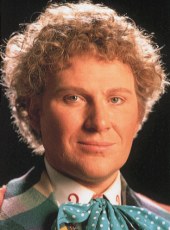 | | The Sixth Doctor |
|
| | | | |
 | | Peri |
| 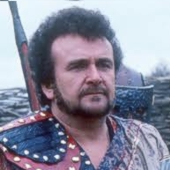 | | Sabalom Glitz |
|  | | Melanie Bush |
| | | | |
|
On Release | | The Collection Season 23 Limited Edition Blu-Ray Cover |

VIDEO |
| | 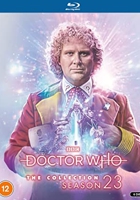 | | The Collection Season 23 Standard Edition Blu-Ray Cover |

VIDEO |
| | | | |
Magazines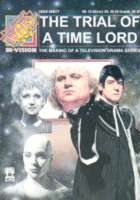 | | Doctor Who CMS Magazine (In Vision): Issue 90: The Trial of a Time Lord |
|  | | Doctor Who Magazine - Episode Guide: Issue 122 |
| 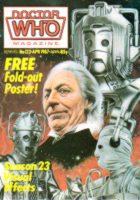 | | Doctor Who Magazine - Article: Issue 123 |
|  | | Doctor Who Magazine - Episode Guide: Issue 161 |
| | | | |  | | Doctor Who Magazine - Countdown to 50: Issue 453 |
|
|
|
|
| |
| |
|
| |
| |
|
| Doctor Who is the copyright of the British Broadcasting
Corporation. No infringements intended. This site is not endorsed by the BBC or
any representatives thereof. |
|